新外研版八年级上Module6 Animals in dangerUnit 3
- 格式:ppt
- 大小:1.48 MB
- 文档页数:39
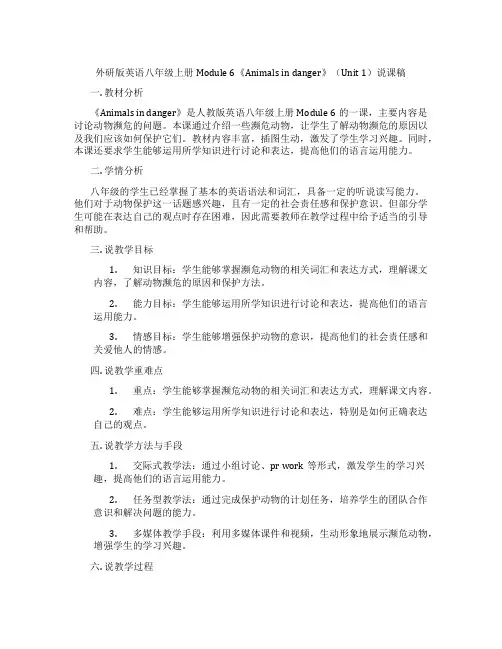
外研版英语八年级上册Module 6《Animals in danger》(Unit 1)说课稿一. 教材分析《Animals in danger》是人教版英语八年级上册Module 6的一课,主要内容是讨论动物濒危的问题。
本课通过介绍一些濒危动物,让学生了解动物濒危的原因以及我们应该如何保护它们。
教材内容丰富,插图生动,激发了学生学习兴趣。
同时,本课还要求学生能够运用所学知识进行讨论和表达,提高他们的语言运用能力。
二. 学情分析八年级的学生已经掌握了基本的英语语法和词汇,具备一定的听说读写能力。
他们对于动物保护这一话题感兴趣,且有一定的社会责任感和保护意识。
但部分学生可能在表达自己的观点时存在困难,因此需要教师在教学过程中给予适当的引导和帮助。
三. 说教学目标1.知识目标:学生能够掌握濒危动物的相关词汇和表达方式,理解课文内容,了解动物濒危的原因和保护方法。
2.能力目标:学生能够运用所学知识进行讨论和表达,提高他们的语言运用能力。
3.情感目标:学生能够增强保护动物的意识,提高他们的社会责任感和关爱他人的情感。
四. 说教学重难点1.重点:学生能够掌握濒危动物的相关词汇和表达方式,理解课文内容。
2.难点:学生能够运用所学知识进行讨论和表达,特别是如何正确表达自己的观点。
五. 说教学方法与手段1.交际式教学法:通过小组讨论、pr work等形式,激发学生的学习兴趣,提高他们的语言运用能力。
2.任务型教学法:通过完成保护动物的计划任务,培养学生的团队合作意识和解决问题的能力。
3.多媒体教学手段:利用多媒体课件和视频,生动形象地展示濒危动物,增强学生的学习兴趣。
六. 说教学过程1.导入:教师通过提问方式引导学生谈论他们喜欢的动物,引出本课主题。
2.呈现:教师通过展示濒危动物的图片和视频,呈现本课的主要内容。
3.讲解:教师讲解课文内容,帮助学生理解动物濒危的原因和保护方法。
4.实践:学生进行小组讨论,讨论如何保护动物,并完成保护动物的计划任务。
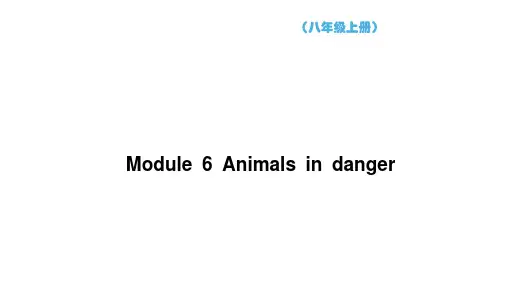
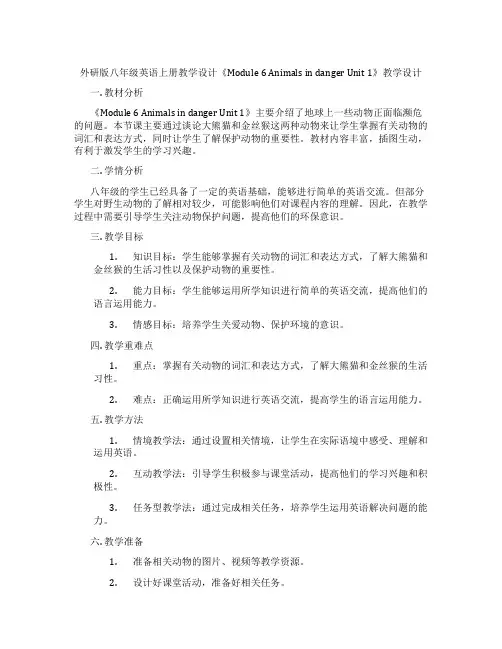
外研版八年级英语上册教学设计《Module 6 Animals in danger Unit 1》教学设计一. 教材分析《Module 6 Animals in danger Unit 1》主要介绍了地球上一些动物正面临濒危的问题。
本节课主要通过谈论大熊猫和金丝猴这两种动物来让学生掌握有关动物的词汇和表达方式,同时让学生了解保护动物的重要性。
教材内容丰富,插图生动,有利于激发学生的学习兴趣。
二. 学情分析八年级的学生已经具备了一定的英语基础,能够进行简单的英语交流。
但部分学生对野生动物的了解相对较少,可能影响他们对课程内容的理解。
因此,在教学过程中需要引导学生关注动物保护问题,提高他们的环保意识。
三. 教学目标1.知识目标:学生能够掌握有关动物的词汇和表达方式,了解大熊猫和金丝猴的生活习性以及保护动物的重要性。
2.能力目标:学生能够运用所学知识进行简单的英语交流,提高他们的语言运用能力。
3.情感目标:培养学生关爱动物、保护环境的意识。
四. 教学重难点1.重点:掌握有关动物的词汇和表达方式,了解大熊猫和金丝猴的生活习性。
2.难点:正确运用所学知识进行英语交流,提高学生的语言运用能力。
五. 教学方法1.情境教学法:通过设置相关情境,让学生在实际语境中感受、理解和运用英语。
2.互动教学法:引导学生积极参与课堂活动,提高他们的学习兴趣和积极性。
3.任务型教学法:通过完成相关任务,培养学生运用英语解决问题的能力。
六. 教学准备1.准备相关动物的图片、视频等教学资源。
2.设计好课堂活动,准备好相关任务。
3.准备好课件,以便于课堂演示。
七. 教学过程1.导入(5分钟)利用图片和视频展示地球上的动物,引导学生关注动物世界。
提问:“你们知道哪些动物正面临濒危?”让学生发表自己的看法。
2.呈现(10分钟)呈现教材中的插图,引导学生观察并说出图中动物的名字。
然后,展示关于大熊猫和金丝猴的图片,让学生用英语描述它们的外貌和生活习性。
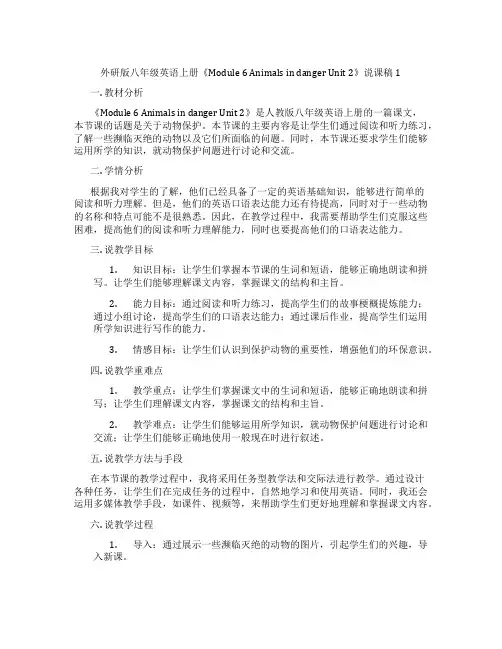
外研版八年级英语上册《Module 6 Animals in danger Unit 2》说课稿1一. 教材分析《Module 6 Animals in danger Unit 2》是人教版八年级英语上册的一篇课文,本节课的话题是关于动物保护。
本节课的主要内容是让学生们通过阅读和听力练习,了解一些濒临灭绝的动物以及它们所面临的问题。
同时,本节课还要求学生们能够运用所学的知识,就动物保护问题进行讨论和交流。
二. 学情分析根据我对学生的了解,他们已经具备了一定的英语基础知识,能够进行简单的阅读和听力理解。
但是,他们的英语口语表达能力还有待提高,同时对于一些动物的名称和特点可能不是很熟悉。
因此,在教学过程中,我需要帮助学生们克服这些困难,提高他们的阅读和听力理解能力,同时也要提高他们的口语表达能力。
三. 说教学目标1.知识目标:让学生们掌握本节课的生词和短语,能够正确地朗读和拼写。
让学生们能够理解课文内容,掌握课文的结构和主旨。
2.能力目标:通过阅读和听力练习,提高学生们的故事梗概提炼能力;通过小组讨论,提高学生们的口语表达能力;通过课后作业,提高学生们运用所学知识进行写作的能力。
3.情感目标:让学生们认识到保护动物的重要性,增强他们的环保意识。
四. 说教学重难点1.教学重点:让学生们掌握课文中的生词和短语,能够正确地朗读和拼写;让学生们理解课文内容,掌握课文的结构和主旨。
2.教学难点:让学生们能够运用所学知识,就动物保护问题进行讨论和交流;让学生们能够正确地使用一般现在时进行叙述。
五. 说教学方法与手段在本节课的教学过程中,我将采用任务型教学法和交际法进行教学。
通过设计各种任务,让学生们在完成任务的过程中,自然地学习和使用英语。
同时,我还会运用多媒体教学手段,如课件、视频等,来帮助学生们更好地理解和掌握课文内容。
六. 说教学过程1.导入:通过展示一些濒临灭绝的动物的图片,引起学生们的兴趣,导入新课。
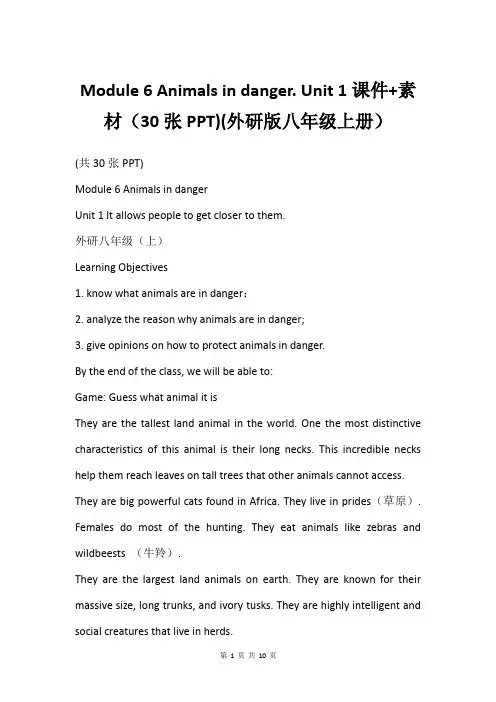
Module 6 Animals in danger. Unit 1课件+素材(30张PPT)(外研版八年级上册)(共30张PPT)Module 6 Animals in dangerUnit 1 It allows people to get closer to them.外研八年级(上)Learning Objectives1. know what animals are in danger;2. analyze the reason why animals are in danger;3. give opinions on how to protect animals in danger.By the end of the class, we will be able to:Game: Guess what animal it isThey are the tallest land animal in the world. One the most distinctive characteristics of this animal is their long necks. This incredible necks help them reach leaves on tall trees that other animals cannot access. They are big powerful cats found in Africa. They live in prides(草原). Females do most of the hunting. They eat animals like zebras and wildbeests (牛羚).They are the largest land animals on earth. They are known for their massive size, long trunks, and ivory tusks. They are highly intelligent and social creatures that live in herds.They are known for their long bodies, lack of limbs and unique method of movement. They have the ability to swallow their prey(猎物)whole due to their flexible jaws(灵活的下颌).They are known for their stocky (矮胖的)build, large size, and sharp claws. They have a diverse diet, ranging from plants and fruits to fish and even meat. They are excellent swimmers and climbers, with a keen sense of smell. They hibernate during the winter months.Do you know which of the following animals are endangered★Some are endangered, such as Bungarus multicinctus金环蛇endangeredendangeredendangeredvulnerable species易危物种protected species保护物种What other endangered animals do you know Please judge if the animals below are endangered.endangeredendangeredendangeredprotected species保护物种golden monkeysquirrelwhalesouth China tigerendangeredsea turtleWhat a video and answer why some animals are endangered.In this video, why are some animals endangeredHabitat destruction栖息地破坏、Pollution污染、Invasive species外来物种入侵、Climate change气候变化、Disease and predation疾病和捕食压力.Because people kill these animals. They killed tigers for bones and elephants for ivory, etc.Besides human killing, what are the other reasons lead to animals in dangerThere is a TV show called Animal World. Listen and answer the questions.1. What’s this week’s Animal World about2.How about last week3. Are pandas endangered animals For your knowledge, what actions have the government taken to protect pandas1. What’s this week’s Animal World about2.How about last week3. Are pandas endangered animals For your knowledge, what actions have the government taken to protect pandasThis week’s Animal World is about snakes.They are vulnerable animals(易危动物). China has established a series of nature reserves in panda habitats and protected the panda's habitat. Last week it told why there’s so few pandas.The government build many nature reserves to protect animals, e.g. Wolong Panda Reserve.Now listen and answer the questions.1. What animal does Betty want to see most at the zoo2. Where does Betty think is a better place to see pandas Why Pandas.She thinks the Wolong Panda Reserve is better, because it allows people to get closer to them.3. Why are many animals in danger4. What can we do to help them5. What did the zoo do to protect the animalsMany wild animals don’t have a safe place to live and there isn’t enough clean water.We can give money to help protect the animals, such as raising some money at school. And we can find out what else we can do to save as many animals as possible.It shows a notice.(Lingling and Betty are leaving the zoo.)Lingling: Did you like the zooBetty: Yes! I saw the pandas at last! But I am more interested to see the pandas in the Wolong Panda Reserve, because it allows people to get closer to them.Lingling: It’s sad to think of the pandas and other animas in danger. Betty: We need to protect them better.Lingling: Yes. Many wild animals don’t have a safe place to live, because villages and farms are growing bigger and are taking away their land and forests.Listen and read, then complete the table.Betty: Also, often there isn’t enough clean water. I think we all need to help animals live in peace. Look, there’s a notice.Lingling: It says, “Help! We want to save animals in danger, and we need your help.”Betty: But what can we doLingling: It says, “Your money pays to look after the animals.” That means we can give money to help protect the animals.Betty: Maybe we can raise some money at school. Let’s find out what else we can do to save as many animals as possible.Complete the sentences with the correct form of the words in the box. allows danger enough in peace protect raiseMany wild animals, such as pandas, are in (1)________. We need to(2)__________ them! Often there is not (3) __________water or forests, so the animals do not have a safe place to live.The Wolong Panda Reserve (4) ___________ people to get closer to the pandas. And pandas live (5)_________there. You can help us (6) ________ money to protect pandas and other wild animals.dangerprotectenoughallowsin peaceraiseWork in pairs. Talk with about what else we can do to protect the animals in danger in our daily lives.not to kill themfor foodnot to wear clothes made of animal furnot to cutdown treesDon’t buy products(产品)made with anything from animals in danger. We must make laws to punish(惩罚)people who kill animals.We should stop people from killing animals.We can make posters to promote the idea of protecting animals.Try to be friendly to the animals.Other ways we can do:Discuss with your partner.1. What’s your favorite animal2. What’s its living habit3. What is its current state of existence4. What can we do to help the animalsWritingNow try to write a passage about your favorite animal.Example:My favorite animal is pandas. They live in the forest and the wild. They like eating bamboos. They are black and white, also, they are very cute. But for a long time, they are in danger. Because there are fewer forests to live in and bamboos to eat because of human activities. Now, with the help of government and many people, there are more pandas than before, and they turn endangered animals into vulnerable animals. In the future, I will make posters to promote the idea of protecting animals. I hope every animal has a good living environment , and there are fewer and fewer endangered animals.Listen and mark when the speaker pauses.pronunciation and speakingNow, listen again and repeat.1 It allows people to get closer to the pandas.2 We want to save animals in danger,and we need your help.3 We can give money to help protect the animals.在英语口语中,停顿是一种常用的语音技巧,用于表达思考、补充信息或者调整语气。
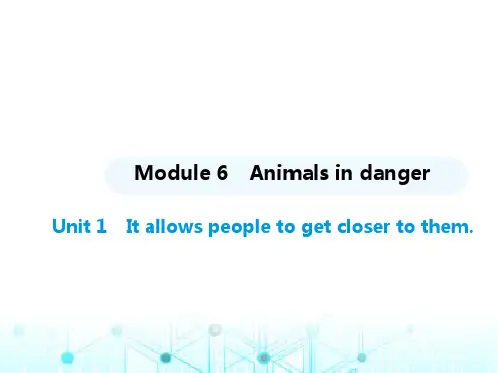
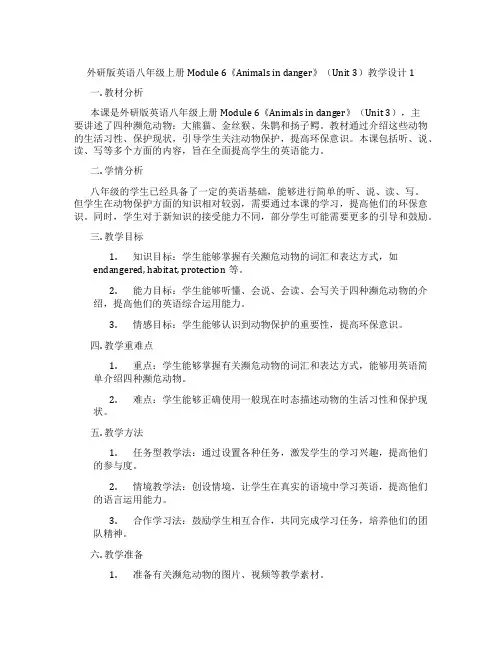
外研版英语八年级上册Module 6《Animals in danger》(Unit 3)教学设计1一. 教材分析本课是外研版英语八年级上册Module 6《Animals in danger》(Unit 3),主要讲述了四种濒危动物:大熊猫、金丝猴、朱鹮和扬子鳄。
教材通过介绍这些动物的生活习性、保护现状,引导学生关注动物保护,提高环保意识。
本课包括听、说、读、写等多个方面的内容,旨在全面提高学生的英语能力。
二. 学情分析八年级的学生已经具备了一定的英语基础,能够进行简单的听、说、读、写。
但学生在动物保护方面的知识相对较弱,需要通过本课的学习,提高他们的环保意识。
同时,学生对于新知识的接受能力不同,部分学生可能需要更多的引导和鼓励。
三. 教学目标1.知识目标:学生能够掌握有关濒危动物的词汇和表达方式,如endangered, habitat, protection等。
2.能力目标:学生能够听懂、会说、会读、会写关于四种濒危动物的介绍,提高他们的英语综合运用能力。
3.情感目标:学生能够认识到动物保护的重要性,提高环保意识。
四. 教学重难点1.重点:学生能够掌握有关濒危动物的词汇和表达方式,能够用英语简单介绍四种濒危动物。
2.难点:学生能够正确使用一般现在时态描述动物的生活习性和保护现状。
五. 教学方法1.任务型教学法:通过设置各种任务,激发学生的学习兴趣,提高他们的参与度。
2.情境教学法:创设情境,让学生在真实的语境中学习英语,提高他们的语言运用能力。
3.合作学习法:鼓励学生相互合作,共同完成学习任务,培养他们的团队精神。
六. 教学准备1.准备有关濒危动物的图片、视频等教学素材。
2.设计各种任务,如填空、选择、问答等,以便在课堂上进行操练。
3.准备听力材料,让学生听懂四种濒危动物的介绍。
七. 教学过程1.导入(5分钟)利用图片、视频等素材,引导学生关注四种濒危动物,激发他们的学习兴趣。
2.呈现(10分钟)呈现教材中的听力材料,让学生听懂四种濒危动物的介绍。
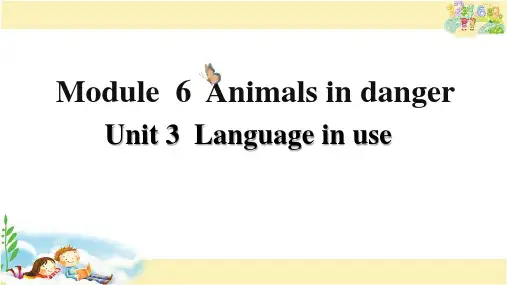
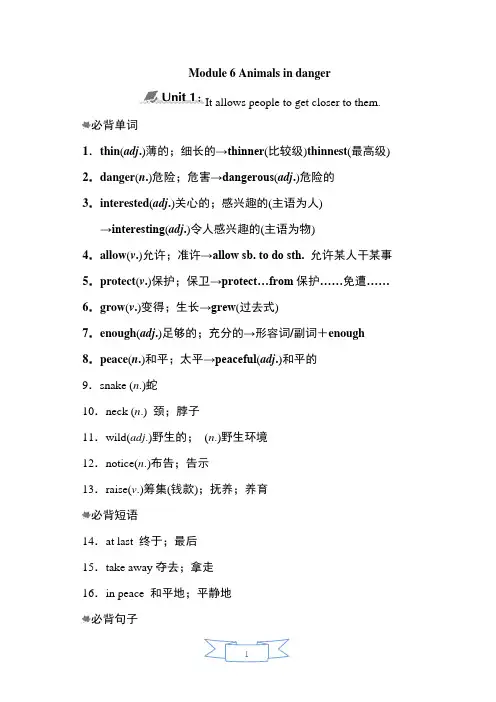
Module 6 Animals in dangerIt allows people to get closer to them. 必背单词1.thin(adj.)薄的;细长的→thinner(比较级)thinnest(最高级) 2.danger(n.)危险;危害→dangerous(adj.)危险的3.interested(adj.)关心的;感兴趣的(主语为人)→interesting(adj.)令人感兴趣的(主语为物)4.allow(v.)允许;准许→allow sb. to do sth. 允许某人干某事5.protect(v.)保护;保卫→protect…from保护……免遭……6.grow(v.)变得;生长→grew(过去式)7.enough(adj.)足够的;充分的→形容词/副词+enough 8.peace(n.)和平;太平→peaceful(adj.)和平的9.snake (n.)蛇10.neck (n.) 颈;脖子11.wild(adj.)野生的;(n.)野生环境12.notice(n.)布告;告示13.raise(v.)筹集(钱款);抚养;养育必背短语14.at last 终于;最后15.take away夺去;拿走16.in peace 和平地;平静地必背句子17.It allows people to get closer to them.它允许人们更近距离地接触它们。
18.It's sad to think of pandas and other animals in danger.想起大熊猫和其他濒危动物来,真让人伤心。
19.We need to protect them better.我们需要更好地保护它们。
20.Your money pays to look after the animals.你捐的钱用来照顾动物。
21.Let's find out what else we can do to save as many animals as possible.让我们看看还能做些其他的什么来拯救尽可能多的动物。
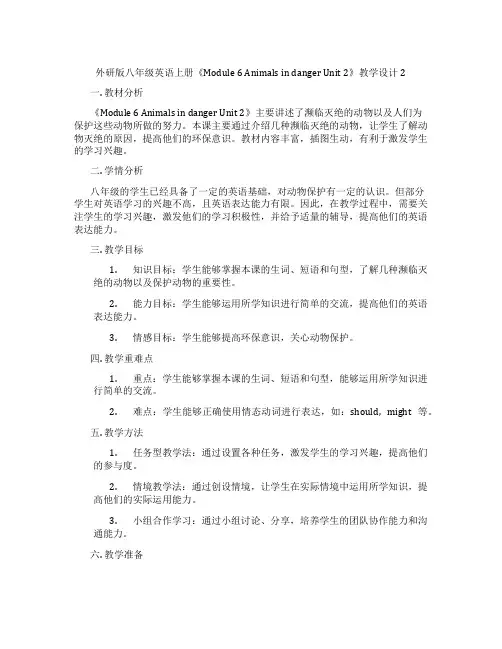
外研版八年级英语上册《Module 6 Animals in danger Unit 2》教学设计2一. 教材分析《Module 6 Animals in danger Unit 2》主要讲述了濒临灭绝的动物以及人们为保护这些动物所做的努力。
本课主要通过介绍几种濒临灭绝的动物,让学生了解动物灭绝的原因,提高他们的环保意识。
教材内容丰富,插图生动,有利于激发学生的学习兴趣。
二. 学情分析八年级的学生已经具备了一定的英语基础,对动物保护有一定的认识。
但部分学生对英语学习的兴趣不高,且英语表达能力有限。
因此,在教学过程中,需要关注学生的学习兴趣,激发他们的学习积极性,并给予适量的辅导,提高他们的英语表达能力。
三. 教学目标1.知识目标:学生能够掌握本课的生词、短语和句型,了解几种濒临灭绝的动物以及保护动物的重要性。
2.能力目标:学生能够运用所学知识进行简单的交流,提高他们的英语表达能力。
3.情感目标:学生能够提高环保意识,关心动物保护。
四. 教学重难点1.重点:学生能够掌握本课的生词、短语和句型,能够运用所学知识进行简单的交流。
2.难点:学生能够正确使用情态动词进行表达,如:should, might等。
五. 教学方法1.任务型教学法:通过设置各种任务,激发学生的学习兴趣,提高他们的参与度。
2.情境教学法:通过创设情境,让学生在实际情境中运用所学知识,提高他们的实际运用能力。
3.小组合作学习:通过小组讨论、分享,培养学生的团队协作能力和沟通能力。
六. 教学准备1.教学课件:制作包含图片、动画等多媒体元素的教学课件,吸引学生的注意力。
2.教学材料:准备相关的动物图片、视频等教学材料,帮助学生更好地理解课文内容。
3.录音机、耳机等音响设备:用于播放课文录音,提高学生的听力能力。
七. 教学过程1.导入(5分钟)利用图片、动画等导入新课,激发学生的学习兴趣。
向学生提问:“你们知道哪些濒临灭绝的动物?”引导学生谈论动物保护的话题。

Module 6 Animals in dangerUnit 1 It allows people to get closer to them.①I am long and thin.考点1thin/ θɪn/ adj. 薄的;细长的e.g. I’d like to buy a thin blouse. 我想买一件薄衬衫。
I want some thinner paper. 我想要一些更薄的纸。
He was a tall and thin man. 他是个又高又瘦的人。
thin 薄的thick 厚的thin 瘦的fat 肥胖的②What animals are in danger?考点2danger/'deɪndʒə/ n. 危险;危害(1)in danger 处于危险中e.g. We must protect the animals in danger.我们必须保护处于危险中的动物。
(2)out of danger 脱离危险e.g. Luckily, the boy is out of danger.幸运的是,这个男孩脱离了危险。
③But I am more interested to see the pandas in the Wolong Panda Reserve, because it allows people to get closer to them.考点3interested/'ɪntrəstɪd/ adj. 关心的;感兴趣的be interested in sth. 对某物感/ 产生兴趣be interested to do sth. 对做某事感兴趣interesting首音素为元音,用其修饰单数名词时,其前用不定冠词an。
e.g. Today more and more foreign people are interested in Chinese folk music. 今天越来越多的外国人对中国民间音乐感兴趣。
外研版英语八年级上册Module 6《Animals in danger》(Unit 3)教学设计一. 教材分析《Animals in danger》(Unit 3)是外研版英语八年级上册Module 6的一部分,主要介绍了濒危动物的保护。
本节课的主要内容包括四种濒危动物:熊猫、老虎、海豚和犀牛,以及与之相关的短语和句型。
教材通过介绍这些动物的现状,引导学生关注动物保护问题,提高他们的环保意识。
二. 学情分析八年级的学生已经具备了一定的英语基础,能够听懂并参与到课堂活动中。
但他们在口语表达和写作方面仍有待提高。
因此,在教学过程中,需要注重培养学生的口语表达能力和写作能力。
此外,学生对动物保护这一话题感兴趣,有利于激发他们的学习积极性。
三. 教学目标1.知识目标:–学生能够掌握与濒危动物相关的词汇和短语。
–学生能够运用所学句型介绍濒危动物并表达自己的观点。
2.能力目标:–学生能够在课堂上用英语进行流畅的对话。
–学生能够写一篇关于动物保护的短文。
3.情感目标:–学生能够提高环保意识,关注动物保护问题。
四. 教学重难点•学生能够掌握与濒危动物相关的词汇和短语。
•学生能够运用所学句型介绍濒危动物并表达自己的观点。
•学生能够在课堂上用英语进行流畅的对话。
•学生能够写一篇关于动物保护的短文。
五. 教学方法1.任务型教学法:通过完成各种任务,激发学生的学习兴趣,提高他们的参与度。
2.情境教学法:创设真实的情境,让学生在实际语境中学习英语。
3.合作学习法:鼓励学生分组合作,培养他们的团队精神。
六. 教学准备1.教师准备:–制作课件和教学素材。
–准备相关的视频和图片。
2.学生准备:–预习教材,了解本节课的主要内容。
–准备相关的词汇和短语。
七. 教学过程1.导入(5分钟)–教师通过展示濒危动物的图片,引导学生关注动物保护问题。
–学生分享他们对濒危动物的了解和观点。
2.呈现(10分钟)–教师通过课件呈现本节课的主要内容,包括词汇、短语和句型。
Module6 Animals in dangerUnit1 It allows people to get closer to them.1. animals in danger= endanger ed animals濒危动物endanger vt.使处于危险之中endanger ed adj.处于危险之中的(过去分词变来的形容词)in danger处于危险之中out of danger挣脱危险danger-safety n. dangerous-safe adj.2. allow sb. to do sth.赞同、赞同某人做某事Some snakes allow people to touch them.be allowed to do sth.被赞同做某事We are not allowed to eat junk food ( 垃圾食品 ) in the classroom.agree to do sth.dis agree vi.不一样意agree with sb.agree ment n.3. get close(r) to4. sb. be interested to do sth.= It be interesting for sb. to do sth. (it是形式主语,后边的动词不定式是真切的主语)Sb. be interested in (doing) sth.take/ have/ show interest in (doing) sth.对感兴趣He is reading the latest novel by Mo Yan withgreat interest.(介词短语做状语修饰动词reading )他饶有兴趣地阅读莫言的最新小说。
5. think ofHe is sad to think of his dead pet.=It is sad (for him) to think of his dead pet.What do you think of the nature park?=How you do you like ?5.We need to protect animals.sb. need to do sth.sb. need sth./sb.sth. need doing= sth. need to bedone The floor needs sweeping.= The floor needs to be swept.7. wild animals adj.in the wild n. in (the) nature在自然界It ’s natur al for everyone to make miskates.8. grow big /small/ tall/ oldeg: You are growing taller day by day while I’m growing older year by year.你们在一每日地长高而我在一年一年地变老。